Phalaenopsis
Unusually beautiful orchid with bright large flowers of various colors of pink, lilac, yellow, red-cherry, purple, white and lilac shades, whose upper flower petals look like wings of butterflies, frozen on a dark green strong stalk, with specks or color stripes It bears the name Phalaenopsis.
In nature, these beautiful flowers grow in the north of Australia, the Philippines, in the thick and humid tropics of Southeast Asia. They belong to lithophytes - plants that accompany tall trees. Clinging to their mighty trunks by air roots, phalaenopsis receives the substances it needs for its development and moisture practically from the air.
This type of orchid has earned the true love of flower growers, thanks to their ability to bloom for a long time from December to June and not very difficult care. The beauty of Phalaenopsis flowers during flowering is simply fascinating and is a wonderful decoration for greenhouses, rooms and winter gardens. But in order for phalaenopsis to delight you with its beauty all year round, you need to get acquainted with the secrets of caring for them after flowering.
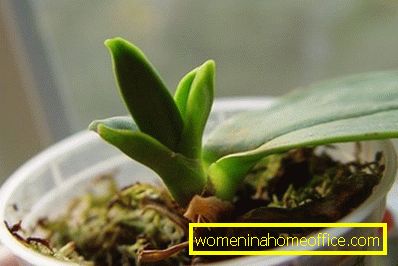
How to care for phalaenopsis after flowering?
Orchid care after flowering depends primarily on the behavior of the peduncle. After phalaenopsis bloom, 2 situations are possible.
- After the fall of the last flowers, the phalaenopsis stems begins to wither. This means the orchid has spent all the accumulated nutrients, gave everything she could and, tired, decided to rest for some time. There is no need to hurry with cutting the peduncle, let it dry out on its own. Drying flower spike gives phalaenopsis the remaining nutrients.
- In the second situation, the phalaenopsis peduncle has already blossomed, but does not develop further and does not dry out. Here you can choose: either leave the orchid alone, and it can even release a new flower, or cut the peduncle 1 cm above the sleeping bud. This will have a stimulating effect on it and a phalaenopsis baby or a lateral peduncle may appear on it.
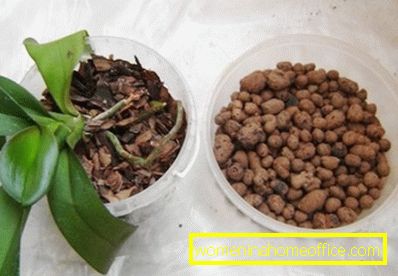
After flowering phalaenopsisomne care should change. The only thing is to reduce the amount and size of fertilizers. If you continue to carefully care for phalaenopsis after flowering, then in 6 months it will give you new fabulous flowers.
Secrets of phalaenopsis care after flowering
- After flowering phalaenopsis is desirable to replant. It is best to do this once every 2 years, more often - it is harmful, and less often - it can slow down the growth and development of the flower.
- Quite often, the phalaenopsis peduncle that has blossomed begins to dry. In this case, it is best to cut. If it remains green and fresh, do not rush to do it. On the old peduncle, the appearance of one more shoots is possible, which very soon will be covered with magnificent flowers.
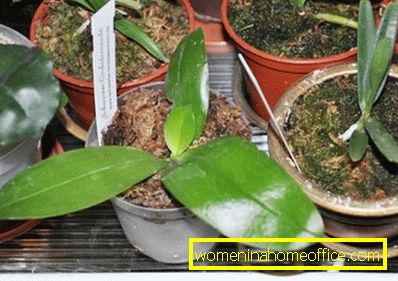
- If daughter outlets have appeared on the flowered peduncle, they can be used for breeding orchids.
- After flowering, the orchid is best left on a tray with coarse sand, and the ambient temperature is kept within 20-220With along with high humidity. This will help the flower to recuperate faster after a beautiful flowering.
- A few days after flowering phalaenopsis enters a state of rest. Therefore, for an orchid of this species, a lower temperature is needed within 15-170WITH.
- Phalaenopsis is watered after flowering is rare, just enough 1 p. in Week.
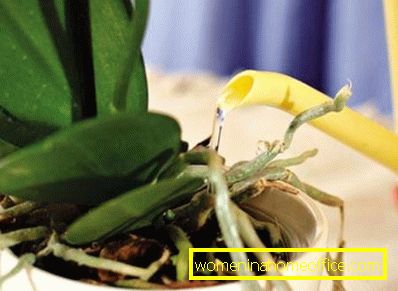
- Since the flower comes from a humid tropics, he loves moisture. Therefore, after flowering, it is necessary to ensure constant moistening of the rosettes of leaves and roots, frequent spraying of the leaves is highly recommended. To do this, you can use the spray. Spraying Phalaenopsis, you can not allow the ingress of water droplets in the center of the outlet, otherwise it may rot the roots.
- Care for this type of orchid after flowering is a snap. Phalaenopsis is generally very convenient for keeping at home. The main difficulty in caring for them after flowering is the implementation of transplants. The thing is that phalaenopsis is very fragile and requires a careful and affectionate attitude. Also, his aerial roots should be all the time in the light, they can not be buried in the ground. For transplanting phalaenopsis, it is best to use transparent pots made of glass or hard plastic. The soil for transplanting is made from a mixture of fine expanded clay, ground for coniferous wood, finely chopped oak or pine bark, a small amount of charcoal and dry peat moss necessarily porous. The easiest way to get ready land for the flower.
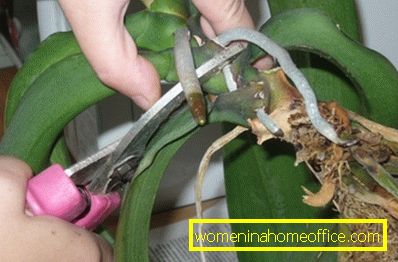
- Phalaenopsis is planted in the center of the pot, and the roots are sprinkled with ready-made substrate, covering the top with fibrous peat or moss. Phalaenopsis should not be treated in the same way as other indoor flowers. After flowering from excessive moisture, its aerial roots can wither, and sometimes they require drying. But also because of the lack of water, phalaenopsis after flowering lowers the leaves down, and if you don’t water it in time, the leaves become wrinkled and thin.
Read also:
- Phalaenopsis orchid transplant at home
- How to care for azalea after flowering?
As soon as your phalaenopsis disappeared, continue to care for it, as before, gradually reducing the ambient temperature, the number of fertilizing and watering. Instead, increase the spraying and let the flower stem bloom. It doesn’t hurt to remember some features of caring for them after flowering, so that after 5 months the phalaenopsis orchid again presents you with a fairy tale. Do not forget about the care of phalaenopsis after flowering, and it will please you many times with unusually beautiful and fabulous flowers.